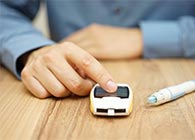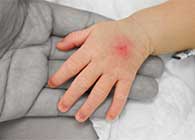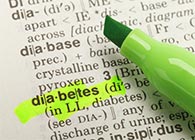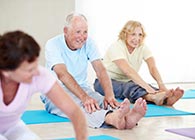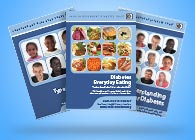Planning to Lose Weight?
By Katharine Morrison – a GP with a son who has Type 1 diabetes
Becoming and keeping slim is of even greater benefit to people who have diabetes than the general population. Abdominal obesity promotes insulin resistance and insulin resistance promotes abdominal obesity. Worsening of blood sugar control and the insidious death of overworked pancreatic beta cells results.
Most people know what to eat and what not to eat to stay thin. They just don’t follow their plan consistently enough says weight loss doctor Stephen Gullo. He asks his patients, “Do you really love this food so much that you want to wear it?”
He has many tips and strategies to help people succeed and these are published in his best selling book, “The Thin Commandments.”
Keeping a written record of all the food you consume is a good starting point. Instead of grazing throughout the day or alternatively delaying and missing meals he recommends planned eating about every four hours. The food of course cannot be any old thing that is around. You must plan ahead. A simple and obvious thing to do, isn’t it?
Yet, many things seem to get in the way of such a straightforward action plan. Emotional eating, food cravings, distractions, huge portions, just plain boredom. Every meal is a weight losing, gaining or maintaining opportunity. You have the choice.
It can be difficult to deal with carbohydrate and other cravings especially if you are sleep deprived or stressed. A high protein or high fibre breakfast can help. Protein shakes are portable and can blunt that sweet tooth. It is much easier not to buy food that you overeat rather than attempt to resist it once it is in your cupboard. High sugar or fructose plus fat seems to be the worst combinations for craving which stimulates fat storage. This combination is widely available in processed and fast foods.
Many people are quite frugal eaters till they get home at night. By then they are starving and then there is no holding back. An afternoon snack around 4 pm can help especially if it is of the filling high protein/high fibre type. Following this with an evening meal with high fibre vegetables, salad, and an adequate amount of protein will keep you going till morning without over doing the calories.
Hunger outside with meal times usually means you have underdone the protein or overdone the rapidly acting carbohydrate at the previous meal. Your daily protein requirement can be worked out by dividing your ideal weight in kilograms by six. If a woman weighs 60kg for instance she will need 10 oz of lean protein a day split between meals and snacks as a minimum. One egg is around one ounce of protein if this makes size estimation more meaningful.
When you shop for food go on a full stomach and don’t buy naughty things for “someone else”. Make a list and stick to it. For many people internet grocery shopping can help. What things do you find difficult to resist?
Apart from not actually buying and eating the stuff what else can you do to take your focus away from food? Social activiies, exercise, self soothing activities and house and garden work are all possibilities. “Why are they so unattractive compared to eating a tube of Pringles in front of the telly?” I can’t help but ask myself.
Dr Gullo insists that your lifelong success at weight control depends on how well you handle the foods that tempt you the most. For each food you have any sort of problem with you need to decide whether you can truly limit your consumption to special occasions or whether you need to eliminate that food entirely. This may seem rather harsh, but for virtually everyone a complete ban is actually easier than a plan to moderate consumption. It is an addiction after all.
Here are three tips to control cravings:
- Is it hunger? Eat cold meat or a boiled egg.
- Desperate for something sweet? Rinse your mouth out with dry wine, lemon juice or vinegar.
- Desperate for something salty? Eat something sweet like a square of high cocoa chocolate or suck an artificial sweetener tablet.
If you do go ahead and guiltily get tucked into your personal equivalent of my Pringles problem, what do you do next? Many people will do the manana, manana thing. I’ve done it now, so I may as well have toasted cheese, the kids’ smarties, the leftover quiche and start again tomorrow. No. No. No. Says Dr Gullo. You must get back on the wagon right away. This is not your last meal. There are lifetime consequences on your health you know. You need to eat foods that you like and are nutritious and that fill you up. And you must do this consistently.
The best foods to fill you up are white meat, fish and seafood, high fibre low starch vegetables and eggs. High calcium dairy foods, grapefruit and cinnamon can also enhance weight loss. Removing unnecessary fat from you meals by attention to cooking methods. Removing dressings and sauces also helps. Be careful to avoid alternatives such as “lite” dressings that are bulked out with sugar. Just cut them down.
Drinking water, eating meals that contain a fixed amount of calories and exercise are all strategies that help weight loss.
As we know the first and last three minutes of our lives are the most dangerous. And it’s a bit like this when you go into a restaurant. In the first ten minutes you are choosing what to eat and drink and are possibly getting stuck into the bread and butter. In the last ten minutes you have the desserts and cheese and biscuits and the bill to contend with.
Once you are a weight you are happy with it can be just as hard to keep it off. To do this you need to keep to your good habits and not go back to your self defeating ways. Remember that it will be the same old stuff that is likely to trip you up. You may have lost a lot of weight but you will never lose your vulnerability to the old habits.
As a society we do tend to reward ourselves with food as we celebrate life events and relieve our misery over daily events. How can you reward yourself differently? How can you promote healthy eating habits to get the best out of your life?
![]()





